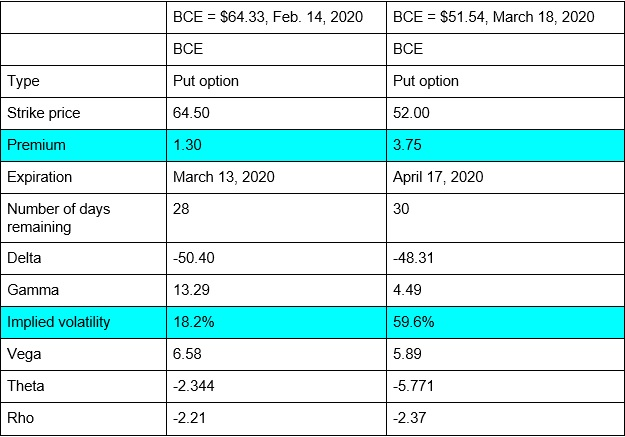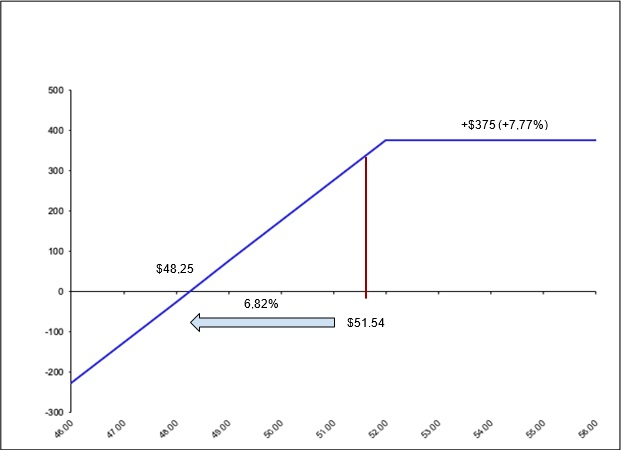Making the most of volatility in these uncertain times

In our last article we discussed how to reduce the risk associated with the time-value decay of options in a directional position. Now we will take advantage of the market meltdown to discuss the implied volatility in the price of an option, how it reflects the degree of market uncertainty over future price movements in the underlying security, and how to make the most of this phenomenon.
Volatility
What is volatility? Generally speaking, the volatility of a stock is the tendency of its price to rise or fall. The more that a stock price fluctuates, the higher its volatility. Volatility is therefore a measure of the risk associated with changes in the returns on a particular stock, or on the market in general. So the more volatile a stock, the riskier it is.
There are two types of volatility: historical volatility and implied volatility. Historical volatility is measured using historical prices, while implied volatility is calculated using the price of an option. As a result, historical volatility reflects past risk, and does not necessarily predict future risk. However, since volatility is a variable in option pricing models, we can take a given option price and use it to derive the amount of volatility that needs to be entered into the model to obtain that price. This implied volatility therefore reflects market expectations of future changes in returns on the price of the underlying share. The higher the implied volatility, the more the market anticipates large fluctuations in future returns on the underlying stock, and vice versa.
Volatility before and after the meltdown
Table 1: Data on 64.50 put options expiring on March 13, 2020, as at February 14, 2020, compared to 52.00 put options expiring on April 17, 2020, as at March 18, 2020

Source: Montréal Exchange and Martin Noël
Table 1 above shows a marked increase in volatility (18.2% to 59.6%) from the at-the-money options maturing on March 13, 2020 to those maturing on April 17, 2020. This greater volatility resulted in a proportional increase in the premium, from $1.30 to $3.75. As we can see, buying protection now costs us more than it did before the meltdown. This should come as no surprise, since what we have here is the basic principle of insurance at work; insurance premiums always tend to go up in the wake of major disasters. So if you want to protect a position, you will need to find a way to reduce the cost of this protection. For example, if you believe that the bear market will continue to fall and you want to obtain some protection, you can implement a bear spread using put options as discussed in our previous article. By selling put options in a bear spread, you reduce the negative impact of time-value decay on the put options purchased. However, if you believe that, after falling almost 25%, the price of BCE Inc. (BCE) shares presents a buying opportunity in the short to medium term, then you can take advantage of the higher implied volatility and, by extension, of the higher premium on BCE options, by selling put options and acting as the insurer instead. Keep in mind that when you sell put options, you will be obliged to buy the underlying shares at the strike price if the holder exercises the contract.
Chart 1: Profit and Loss Diagram for $52.00 Put Options Expiring on April 17, 2020

Source: Martin Noël
As can be seen in Chart 1 above, if we sell the BCE 52.00 put options expiring on April 17, 2020 (BCE200417P52.00) for $3.75, we will be able to buy the shares at a break-even price of $48.25 (the $52 strike price less the $3.75 premium received). This represents an additional 6.82% of protection from their current price of $51.54, if BCE closes at a price below $52 when the options expire on April 17, 2020. Should BCE close above $52, we can realize a profit of $375 per contract or $3.75 per share, for a return on risk capital of 7.77% (the $3.75 premium received divided by the $48.25 break-even).
In conclusion, recent events show how option premiums rise sharply in an environment of high volatility. As a result, it costs more to obtain protection against further declines in both the short and medium term. This situation puts the insurance buyer at a disadvantage, but it also presents an opportunity to anyone willing to take a calculated risk. As the above example shows, the investor who sells put options in such an environment (and after a correction of nearly 25%) effectively commits to buying shares with an additional 6.82% margin of protection. In sum, if there is a turn of events such that we are obliged to buy the shares, we would get them at a level representing a correction of almost 32%. So when entering into such a transaction you need to be aware that you could find yourself with an equity position in a bear market that risks to stretch even further into the foreseeable future. Consequently, a position like this should only be taken with all the facts in hand.
Good luck with your trading, and have a good week!
The strategies presented in this blog are for information and training purposes only, and should not be interpreted as recommendations to buy or sell any security. As always, you should ensure that you are comfortable with the proposed scenarios and ready to assume all the risks before implementing an option strategy.
President
Monetis Financial Corporation
Martin Noël earned an MBA in Financial Services from UQÀM in 2003. That same year, he was awarded the Fellow of the Institute of Canadian Bankers and a Silver Medal for his remarkable efforts in the Professional Banking Program. Martin began his career in the derivatives field in 1983 as an options market maker for options, on the floor at the Montréal Exchange and for various brokerage firms. He later worked as an options specialist and then went on to become an independent trader. In 1996, Mr. Noël joined the Montréal Exchange as the options market manager, a role that saw him contributing to the development of the Canadian options market. In 2001, he helped found the Montréal Exchange’s Derivatives Institute, where he acted as an educational advisor. Since 2005, Martin has been an instructor at UQÀM, teaching a graduate course on derivatives. Since May 2009, he has dedicated himself full-time to his position as the president of CORPORATION FINANCIÈRE MONÉTIS, a professional trading and financial communications firm. Martin regularly assists with issues related to options at the Montréal Exchange.
The information provided on this website, including financial and economic data, quotes and any analysis or interpretation thereof, is provided solely for information purposes and shall not be construed in any jurisdiction as providing any advice or recommendation with respect to the purchase or sale of any derivative instrument, underlying security or any other financial instrument or as providing legal, accounting, tax, financial or investment advice. Bourse de Montréal Inc. recommends that you consult your own advisors in accordance with your needs before making decision to take into account your particular investment objectives, financial situation and individual needs.
All references on this website to specifications, rules and obligations concerning a product are subject to the rules, policies and procedures of Bourse de Montréal Inc. and its clearinghouse, the Canadian Derivatives Clearing Corporation, which prevail over the content of this website. Although care has been taken in the preparation of the documents published on this website, Bourse de Montréal Inc. and/or its affiliates do not guarantee the accuracy or completeness of the information published on this website and reserve the right to amend or review, at any time and without prior notice, the content of these documents. Neither Bourse de Montréal Inc. nor any of its affiliates, directors, officers, employees or agents shall be liable for any damages, losses or costs incurred as a result of any errors or omissions on this website or of the use of or reliance upon any information appearing on this website.
BAX®, CADC®, CGB®, CGF®, CGZ®, LGB®, MX®, OBX®, OGB®, OIS-MX®, ONX®, SCF®, SXA®, SXB®, SXF®, SXH®, SXM®, SXO®, SXY®, and USX® are registered trademarks of the Bourse. OBW™, OBY™, OBZ™, SXK™, SXJ™, SXU™, SXV™, Montréal Exchange and the Montréal Exchange logo are trademarks of the Bourse. All other trademarks used are the property of their respective owners.
© 2024 Bourse de Montréal Inc. All Rights Reserved.
